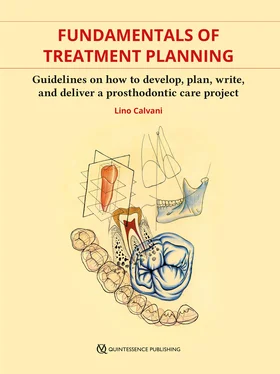1 ...6 7 8 10 11 12 ...25 59.Alexander ER. Approaches to Planning: Introducing Current Planning Theories, Concepts and Issues. Luxembourg: Gordon and Breach Science Publishers SA, 1992.
60.IBM – Watson Machine Learning. https://www.ibm.com/cloud/machine-learning. Accessed 29 June 2019.
CHAPTER TWO
Treatment planning management
We often take our knowledge for granted, which in the medical field is a dangerous thing. While good sense and innate wisdom drive the profession, things are changing so quickly in our technological age that we need to constantly keep ourselves informed about new terms, concepts, rationales, procedures, and ideas in order to offer our patients the best treatments possible. The science is not static but must be constantly learned, understood, reviewed, and remembered. Only then are we in a position to formulate the best treatment plan.
So, what is the goal of a prosthodontic treatment plan? In most cases, patients come to us because they have an esthetic and/or functional problem in their oral cavity. It is understandable that they are not concerned about the physiology of the entire oral system and how all aspects of it are interrelated. What is not so understandable is how many dental medical professionals think it is sufficient to treat the teeth only, ignoring the overall context in which the masticatory system works. Considering the part as inseparable from the whole is the basis of the holistic approach to medical and dental practice.
Prosthodontists need to solve problems in the oral cavity, but that is not just a matter of teeth. Indeed, they need to find the best possible way of healing the oral cavity and its potential clinical problems, taking into account all the structural and biomechanical issues. They then need to rehabilitate the patient’s oral health in its entirety, focusing on the dentition and its compromised or lost functions, while also taking into account the patient’s needs, wishes, and expectations. Prosthodontists are called upon to improve the function of the dentition as well as the patient’s comfort and quality of life so that both physical and psychologic health are restored.
Prosthodontists should be equipped to manage treatment planing with understanding, expertise, and professionalism. This entails a sound knowledge of patient management, organization, and what is available in terms of clinical therapies that can be suggested to the patient.
Therefore, after the diagnosis, treatment planning is the moment where all the various aspects of education, knowledge, understanding, expertise, experience, observational capabilities, reasoning, dexterity, skills, ethical awareness, responsibility, communication, and critical thinking are distilled into one focus. From this focal point, treatment plans are conceived and presented to the patient. At this moment, professional values such as clarity, precision, and accuracy are key.
What follows are some basic concepts, definitions, and suggestions related to this aspect of the topic. Some may feel that their professional experience means they will not benefit from this level of basic analysis. But for those who humbly approach this subject with an open mind, these basic concepts will hopefully be useful to tune in, so to speak, to the matter of prosthodontic thought in order to enhance their knowledge and understanding. It should also be borne in mind that, unfortunately, the speciality of prosthodontics still does not exist institutionally in many parts of the world outside of the USA.
Some definitions and basic premises
The three cornerstone definitions are:
● Treatment: According to the Cambridge Dictionary, the word ‘treatment’ is defined as “the way in which somebody behaves towards or deals with somebody or something.” 1In the sense of medical treatment, it refers to the care given to a patient in response to an illness or injury, and in the case of dental medical treatment, in response to an issue or issues concerning the oral cavity.
● Plan: A plan has been defined as “an individual or collaborative enterprise that is carefully planned to achieve a particular aim.” 2Indeed, a plan is what results after:
● all the appropriate data have been acquired;
● the situation has been carefully studied;
● all the details are understood;
● appropriate conclusions have been drawn;
● one or more solutions necessary to solve the problem/s have been formulated.
● Purpose: The purpose of treatment planning in prosthodontic and restorative dental medicine has been analyzed by many authors.
According to Rosenstiel et al, 3the purpose is to formulate “a logical sequence of treatment designed to repair existing damage and restore the patient’s dentition to good and maintainable health, with optimal function and appearance.”
A treatment plan will only be successful and effective if it is:
● Organized: This important concept may seem obvious but often it is not, so it is emphasized here again that any treatment plan must be well organized and clear, first in the prosthodontist’s mind and then transferred as such to the patient. Only then can the plan be properly understood by the patient.
● Explicable: During treatment planning, we have the chance to understand the prosthodontic rehabilitative course in detail and foresee its possible final results. We then need to organize our conversation with the patient. Indeed, the treatment plan that is well understood and then accepted by the patient is the tipping point after which the clinical treatment may begin.
● Predictable: Predictability of the clinical results is the highest aim of treatment planning. Indeed, during the planning, prosthodontists need to consider all possible variables in order to reduce the likelihood of surprises or pitfalls during the clinical treatment and after the delivery of the prostheses.
Professionalism: four human factors
There are a number of positive characteristics that the prosthodontist (or any clinician) should ideally cultivate and develop in order to grow as a professional. These characteristics are further described in Chapter 7. What follows is a brief description of the main desirable qualities and skills necessary for us to succeed in clinical practice:
1. Proper communication and dialogue with the patient
The ability to communicate clearly is a primary skill. Clear, open communication leads to trust, which is not a given but is something that is earned. Trust is the key to successful patient management and treatment. However, it is not always possible to achieve trust during the first appointment, unless we are able to immediately tune into our patient’s state of mind. Trust often results when we successfully transfer to the patient through optimal communication skills a positive sense of our ability and professionalism from the outset. This entails the ability to clearly explain each step of the procedure and to motivate patients to trust us, to recognize our professionalism and capability, and to feel confident that we are able to solve their problems.
2. Motivating patients
Often, patients must be motivated to be cured. Naturally, a patient’s personality, character, previous experiences, expectations, and other factors may influence this process (this important aspect is discussed later in the book). Clinical experience shows that a number of impediments to communication can be identified when approaching patients such as:
1. Lack of trust or agreement.
2. Stress due to patients’ personal problems.
3. Lack of communication and understanding.
4. Lack of constancy to care.
5. An exacting, fussy, and/or controlling patient.
6. Special physical issues or needs patients may have.
7. Demanding patients, and special psychologic attention they may require.
Читать дальше












